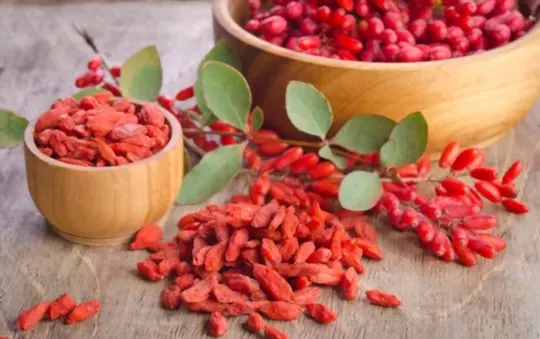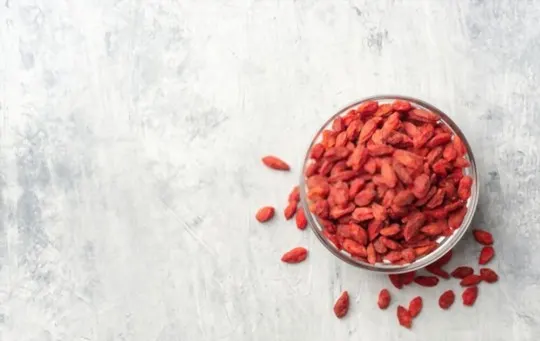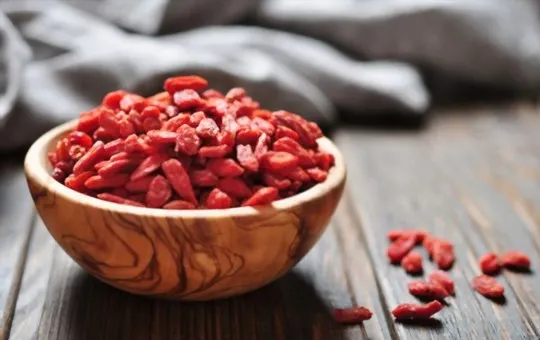If you’re looking for new berries to add to your diet, goji berries will provide you with all the nutrition you need.
These berries are everywhere– at grocery stores, health stores, and supermarkets.
Are they healthy? Yes, they are.
If they’re so appreciated, what do goji berries taste like? They can taste like a mixture of many other berries you’ve probably heard of and tried.
This article will discuss the taste chart, culinary uses, and benefits of goji berries, so keep reading to find out.
What are Goji Berries?

Goji berries are small, oblong, bright red fruits from the boxthorn plant.
They are native to Asia, and China is the largest supplier.
Goji berries are also called wolfberries because the ‘Lycium’ in their scientific name translates to ‘wolf’ in Greek.
This berry is similar to redcurrant in appearance, but both have dissimilar taste profiles.
You will find goji berries in abundance during the summer months.
They grow in clusters like grapes and are picked by hand as they easily become dark when bruised.
When used as food, you can consume goji berries raw (fresh) or dried.
You can powder them to season various dishes or use them as supplements when dried.
The health benefits of goji berries are numerous, but their antioxidant properties and high vitamin content make them favored by many.
And hence, they’re considered superfoods.
These berries also make excellent garnishes, and their rich color is always a plus point.
What Do Goji Berries Taste Like?

The bright and vibrant appearance of goji berries may give you the impression that they’re all sweet and juicy.
But that’s far from the truth; these berries are tangy, and sweetness takes up just a tiny part of the flavor profile.
Fresh goji berries taste sour and have a firm and juicy texture.
The taste is somewhat similar to sour-tasting cranberries.
Dried goji berries taste sweeter and are easier to take in, more like cherries; this is why many prefer to eat them over fresh ones.
The markets generally have more dried goji than fresh ones, and their texture is chewy and sometimes tough.
If you don’t like them chewy, you can rehydrate them to make them soft again.
When you compare the taste of goji to cranberries, you’ll find that both have sweet elements that leave a tangy aftertaste on your palate.
However, cranberries are a lot sourer with a juicier texture.
The nutrition they give is also different.
Cranberries have a lower carb content and offer more iron, calcium, magnesium, and vitamins A, C, and E.
Meanwhile, goji berries have a higher vitamin B complex content.
Because goji berries help raise energy levels and calm you, they are also called ‘happy berries.
’ These berries are like medicine for your kidney.
The taste of goji berries can be too bitter for some palates, so they are added to smoothies and drink to lessen their tannins.
How to Cook and Serve Goji Berries?

The complex tastes of goji berries make them suitable for any kind of sweet or savory dish.
Here are some ways you can maximize the potential of these berries:
Tea: Dried goji berries can make excellent tea options.
It’s good for your eyesight and immune system.
Moreover, its delicate flavors help you relax whenever you need a break.
If you wish to take its flavor even further, consider adding some ginger; you’ll be left with an antioxidant-rich herbal concoction.
Energy bars: Since goji berries are a rich source of essential nutrients, they make good ingredients for energy bars.
Combine them with a few nuts to make the energy bars feel complete.
Soups: Meaty soups, especially chicken, instantly receive a flavor boost by adding dried goji berries.
They tone down the savory element so the sous and make them more rounded and easier to take in.
The bright color also works well as a garnish.
Cereals: Dried goji berries can very well replace raisins in any cereal bowl or oatmeal.
It’ll boost your daily nutritional intake and add a new flavor to your meal.
Despite being packed with many nutrients, there aren’t much scientific data about its effects.
So, it may be a safe choice to consume them in moderation to prevent interaction with other medications.
Conclusion
Eating goji berries will make you understand that appearances can be deceptive.
They’re all bright when fresh, but this is when they’re the sourest.
This is why most goji you find on the markets are dried.
Although these berries can leave your palate unpleasant, you can get all their benefits by adding them to any food.
They work well with chilled and hot meals and are even better when combined with ginger in tea.
But once you have a taste of this berry, you’ll know which way to use it, so it suits your palate.

What Do Goji Berries Taste Like? Do They Taste Good?
Ingredients
- Goji berries
- Ingredients from your favorite recipes
Instructions
- Depending on the ingredients used, the cooking method, and the type of dish, the taste of the food can vary greatly.
- Make sure to select a recipe that will elevate the food’s original flavor, and enjoy experimenting with different recipes!

Andrew Gray is a seasoned food writer and blogger with a wealth of experience in the restaurant and catering industries. With a passion for all things delicious, Andrew has honed his culinary expertise through his work as a personal chef and caterer.
His love for food led him to venture into food writing, where he has contributed to various online publications, sharing his knowledge and insights on the culinary world. As the proud owner of AmericasRestaurant.com, Andrew covers a wide range of topics, including recipes, restaurant reviews, product recommendations, and culinary tips.
Through his website, he aims to inspire and educate fellow food enthusiasts, offering a comprehensive resource for all things food-related.

Leave a comment